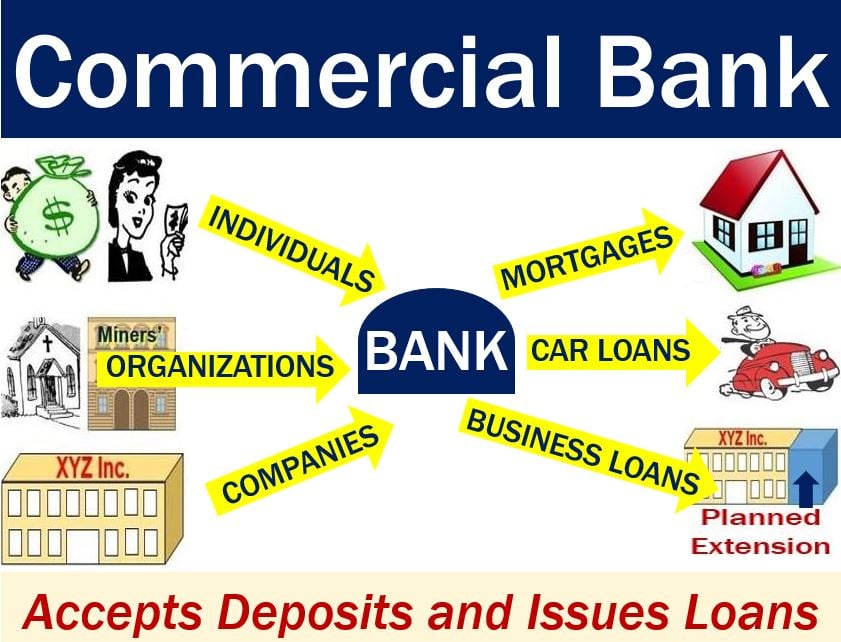A Commercial Bank is a financial institution that provides deposit, current, and saving accounts. A current account is the same as a checking account. A commercial bank serves individuals, organizations, and businesses. It also lends money. In the United Kingdom, people also call it a high street bank.
The term may be ambiguous. Some people say a commercial bank is a bank’s division that just deals with companies.
Commercial banks make money by taking short-term deposits and turning those funds into bigger, long-term maturity loans. This process, which transforms their assets, generates income. In other words, they make a profit by taking people’s money and lending it.
Commercial banks contrast with investment banks. Investment banks’ main businesses include securities trading, asset management, mergers & acquisition advisory, and securities underwriting. Aside from central banks, there are two main types of banks: investment and commercial banks.
The term ‘investment bank’ means the same as ‘merchant bank.’
Many large commercial banks also have investment banking divisions. However, retail banking makes up the bulk of their operations.
Commercial bank – main function
The main function of a commercial bank is to accept deposits. In fact, without getting deposits, it cannot make loans and investments.
We deposit their money in banks because we want to keep it safe. We also want to earn interest. Furthermore, we need easy access to our money through ATMs, checks (UK: cheques), and payment cards.

Banks offer different types of accounts to suit the needs of customers. Below are some examples:
– Fixed Deposits: the customer deposits a lump sum for a set period.
– Savings Deposits: ideal for customers wishing to build up small savings. The bank pays higher interest rates than in checking accounts. However, interest rates are lower than in fixed deposits.
– Current Deposits (Checking Accounts): customers can pay in and take out money whenever they like. The bank does not usually pay interest. In fact, the bank may even charge a small fee.
These accounts usually have an overdraft facility for customers who qualify.
– Recurring Deposits: the customer deposits a fixed amount every month for a set period. The bank pays interest. At the end of the period, the customer can either withdraw the money or renew for another term.
Commercial banks also process payments, issue checks, provide cards, and lend money. They deal in foreign exchange transactions, issue traveler’s checks, and offer safety deposit boxes.
Some commercial banks may give investment advice and offer brokering insurance contracts.
Investment vs. commercial bank
It is getting progressively harder to tell commercial banks from investment banks. From 1933 to 1999, thanks to the Glass-Steagall Act (the US only), it was quite easy.
If you took deposits and lent money, you were a commercial bank. On the other hand, if you helped businesses issue shares, you were an investment bank.
By the end of the 1990s, it became progressively more difficult to enforce Glass-Steagall. In fact, it eventually became impossible.
Today, we have to look at where the bulk of a bank’s activities are to determine what type of bank it is. In other words: “How does it make most of its money?’
In 2012, JP Morgan Chase was the lead underwriter in Facebook’s IPO. IPO stands for initial public offering. IPOs are investment banking activities. However, JP Morgan Chase is a commercial bank.
Modern commercial banks are increasingly embracing digital banking services, offering online and mobile platforms for customers to manage their finances conveniently.
Additionally, they are leveraging fintech partnerships to integrate advanced features like automated investing and real-time payments into their service portfolios.
Understanding “Commercial Bank” in Context
To enhance your grasp of financial discussions, it’s beneficial to see how the term “commercial bank” is employed in various sentences. Here are some real-world examples that illustrate the diverse situations in which the term is applicable:
- “The commercial bank offered competitive interest rates on business loans, enticing local entrepreneurs to finance their expansions.”
- “When I started my first job, I opened a savings account with a leading commercial bank to manage my earnings efficiently.”
- “The commercial bank’s mortgage advisor guided us through the home-buying process, making what seemed complex quite straightforward.”
- “Due to its robust cybersecurity measures, the commercial bank was entrusted by numerous customers to safeguard their financial assets.”
- “After the merger, the commercial bank expanded its operations, offering a wider range of services to both individuals and corporations.”
- “The community relied on the local commercial bank to sponsor and support various social initiatives and charity events.”
- “In response to the economic downturn, the commercial bank implemented new policies to provide relief to borrowers facing financial hardship.”
